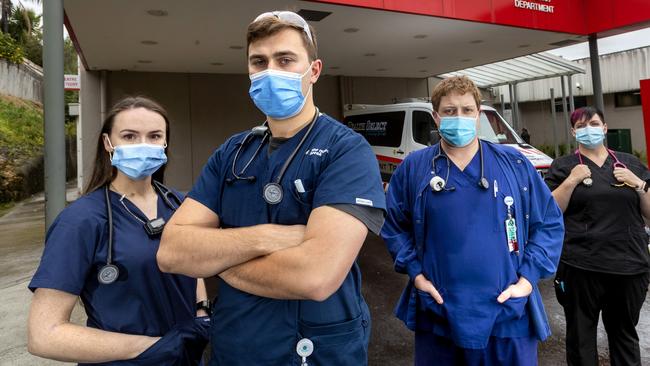Nurses facing wave of violence in NSW, Victoria and Queensland
The rates of violent assaults against healthcare workers has climbed in NSW, Victoria and Queensland, raising serious concern for the welfare of nurses.

The rates of violent assaults against healthcare workers has climbed in NSW, Victoria and Queensland, raising serious concern for the welfare of nurses who are being assaulted by the patients they are trying to help.
In NSW, Bureau of Crime statistics show assaults against healthcare workers are up 55 per cent since 2016. In Queensland, violent assaults are up 50 per cent over the same period, with incidents soaring to 12,419 according to Queensland Health.
In Victoria, the number of assaults jumped by 34 per cent, and assaults against police and emergency services more than doubled.
The worst-affected health facilities, according to analysis by The Australian, are Ballarat and Barwon Health in regional Victoria; Metro South and Metro North in Brisbane; Western Sydney’s Blacktown Hospital and Cumberland Hospital; and Sydney’s Royal Price Alfred Hospital and Concord mental health unit.
Melbourne-based senior emergency nurse Helen Dannefaerd said being assaulted by patients was a daily occurrence.
“It differs in levels,” she said. “I’ve been called every name under the sun. Other times it escalates and becomes physical. I’ve been spat on, kicked, bitten. I have friends who have been punched in the face.
“It’s all well and good to say that aggression is not tolerated, but in reality it is tolerated. You can’t very well throw someone out if they require treatment.”
Melbourne emergency nurse Jackson Campbell spoke to The Australian after finishing a night shift when he spent the entire shift answering “code red” alarms.
“Last night I didn’t see a single patient who had presented to the ED,” he said. “I did nine hours straight of seeing patients who had been brought in by police, aggressive and often trying to kill themselves.”
Since becoming a nurse, Mr Campbell has become familiar with the harsh realities of working on the frontline. He founded The Nurse Break, Australia’s biggest nursing platform and support group. Passionate about shedding light on the issue, he has created a documentary-style web series interviewing registered nurses.
“I’ve heard all kinds of abuse. People being kicked, punched, strangled and worse. The nurses in the mental health units have the worst injuries. I think they should wear stab vests,” he said.
Mr Campbell said Victorian nurses received inadequate training on how to deal with violent patients, and there were not enough security guards to help when situations escalated.
“We get two-day courses on how to retain people, but there’s not enough training on how to hold people down,” he said.
“With the aged-care system failing in regards to its management of medical issues, dementia people can become quite violent. And it can be very dangerous with the mental health patients, especially with patients who have schizophrenia and bipolar.”
While each state has a “zero tolerance” policy to violence at work, questions have been raised about the efficacy of state governments’ response in tackling the problem. A NSW Auditor-General Report into NSW Health’s management of health and safety risks in hospitals released in December 2020 was scathing of NSW Health finding it was not effective in managing staff psychological and wellbeing risks, particularly for nurses.
The report found in high-demand wards where incidents and risks were common, staff were unable to log all incidents due to their frequency and the time it took to record them in the system.
Queensland Health implemented its Occupational Violence Strategy Unit task force in 2016 in an attempt to reduce the occurrence of occupational violence in the state’s hospitals.
The task force has pushed to find easier ways to report instances of violence in order to have greater transparency in understanding patterns of behaviour and find ways to improve it. Clinical lead Lisa Olsson was propelled to act when she was punched in the stomach while pregnant while working as a nurse.
“He was a 50-year-old man who had been on a bucks night heavily intoxicated,” she said. “He decided he wanted to leave, and then became unpredictable. He got out of bed and launched at me, and I was 30-weeks pregnant.”
Ex-soldier Dean Douglass spent four years as a security guard in two Queensland Hospitals (Prince Charles and Royal Brisbane and Women’s Hospital) and said he witnessed violence daily, claiming the situation had not improved, but worsened.
Mr Douglass served in Afghanistan, where he was almost killed on multiple occasions, but says he feared for his life more while working in Queensland Hospitals.
“It was like working in a war zone,” he said. “The danger might have been less, but I feared for my own personal safety much more.”
NSW, Victoria and Queensland nurses unions say the culture of underreporting means the number of assaults could be much higher than reported.



To join the conversation, please log in. Don't have an account? Register
Join the conversation, you are commenting as Logout